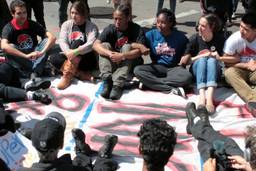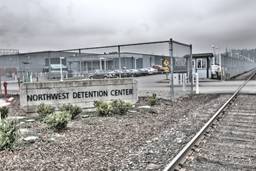
One fall day in October, near the Cochise County town of Sierra Vista in Southern Arizona, an undocumented migrant was walking along state Highway 92 when the driver of a pickup truck pulled over. The driver, who had been going the opposite way, turned his vehicle around. Coming up next to the man, the driver asked if he was “illegal.”
When the man said yes, the driver pulled out a handgun and pointed it at him. Resting the gun on his left arm, the driver cursed the migrant and ordered him to lie down on the pavement. Then the driver picked up his cell phone and called the border patrol.
This was hardly and isolated incident. In fact, it’s practically open season on migrants in southern Arizona.
Because of the heavy border patrol presence at international checkpoints from California to Texas, hundreds of thousands of migrants are funneling into the United States through vast isolated areas of the Sonoran desert. The trip is harrowing, the elements unforgiving. Depending on the season, migrants face either thirst and heat stroke or freezing to death. Since 1994, when “Operation Gatekeeper” in San Diego and similar programs in Arizona and Texas began, more than 2,200 migrants have died trying to cross the U.S.-Mexico border, according to the California Rural Legal Assistance Foundation.
In the past few years, migrants have faced a new danger: overzealous U.S. citizens—often carrying high-powered rifles, sporting homemade badges and wearing camouflage fatigues—have forcefully detained thousands of migrants before turning them over to border patrol agents. Chris Simcox, the founder of Civil Homeland Defense, one of several groups in the region focused on keeping out “illegals,” insists that U.S. citizens have the right to guard the border. “American citizens, under the Second Amendment to the Constitution, have the right to bear arms and to form a militia,” he says, “and I dare the president of the United States to do anything about it.”
But human rights advocates suspect that vigilantes may be involved in a series of recent murders and attacks on migrants in desert areas between Tucson and Phoenix. Though the allegations remain unproven, there is a growing clamor for federal and state law enforcement officials to investigate the civilian militias and rein them in. “These groups are not talking simply about immigration,” says Rep. Raul Grijalva, a Tucson Democrat who represents Arizona’s 7th District. “They are talking about a containment policy based on race, they are talking about a policy that violates human rights, they are talking about a movement that takes the law into their own hands, ignoring due process, ignoring human rights, ignoring civil liberties, and taking it on themselves.”
————–
Simcox, publisher of a small town newspaper in Cochise County called the Tombstone Tumbleweed, brought the level of border paranoia to a new high with his October 24 editorial that issued “a public call to arms” to guard the border. He wrote: “It is time we, the citizens, band together to show our inept Homeland Security Department a thing or two about how to protect national security and the sovereignty of our Democratic Republic.”
Appearing for an interview at his office in Tombstone wearing a gun holstered to his hip, Simcox maintains he has “all the respect in the world for human rights.” Be that as it may, Simcox says he and his posse plan to patrol water towers set up by good Samaritans in response to the number of migrants who have died of thirst while trying to cross the desert. When asked whether the presence of Civil Homeland Defense might intimidate migrants from trying to get water, he replies: “So? Look, anybody who would take a chance to come across that border and walk across that desert must know what they are getting into.”
Simcox, a former teacher at a private school in the Los Angeles area, moved to Arizona last year. He claims to have received support from around the nation following his call to arms. “We had a company donate thousands of pairs of plastic handcuffs. They wanted to send us the metal ones, but they make too much noise while you are out there and it’s too dangerous. “
Civil Homeland Defense—which launched its first volunteer patrol for undocumented migrants along an isolated stretch of the U.S.-Mexico border in early January—is not alone in its pursuit of “border crossers.” Farther south, the border town of Douglas, which bumps up against Agua Prieta, Mexico, received notoriety a few years ago after ranchers Roger and Donald Barnett vowed to stop undocumented migrants from entering the United States. The ranchers claim to have detained up to 8,000 migrants in the past four years. They also admit to “roughing up” some of them.
Now they’ve been joined by groups like Ranch Rescue, originating in Abilene, Texas, whose “Operation Hawk” sent armed volunteers in fatigues to patrol Cochise County in October. The group’s organizer, Texan rancher Jack Foote, says Ranch Rescue helps private landowners repair private property destroyed by the “mass numbers of criminal trespassers.” The group says its members include former border patrol agents, military personnel, law enforcement officers and readers of Soldier of Fortune magazine. Ranch Rescue describes people who cross the border as “drug smugglers, criminal gang members, bandits, thugs and international terrorists.”
————–
Another recent arrival is the American Border Patrol (ABP, not to be confused with the federal U.S. Border Patrol), whose leader, Glenn Spencer, moved to Arizona late last year after deciding that “nothing more could be done for California, that no matter who won in the state elections, there would always be an open-border policy.”
Spencer calls his group a combination “think tank and neighborhood watch.” The Southern Poverty Law Center, which tracks neo-Nazi groups across the country, calls ABP a hate group. Spencer has links to the racist, right-wing Council of Conservative Citizens (CCC), one of the largest white supremacist groups in the country. In 1998, Spencer went to Cullman, Alabama, to attend a CCC-organized protest against the growing population of Mexican workers. Spencer also has advertised his anti-immigrant videotape “Bonds of Our Nation” in the CCC newspaper, The Citizen Informer.
According to “Hate or Heroism,” a report released by the Tucson-based Border Action Network (BAN) in December, Spencer was a keynote speaker last February in Herndon, Virginia, at an American Renaissance conference titled “In Defense of Western Man.” (His topic: “The Second Mexican-American War.”) According to its Web site, American Renaissance is an umbrella organization that provides a forum for groups and individuals united in their concern over the “costs of diversity, racial differences in IQ [and] the threat of non-white immigration.”
Operating out of a secret headquarters somewhere near the town of Hereford, ABP uses high-tech surveillance to monitor people crossing the border illegally and uplinks video to the Internet of Roger Barnett and others detaining migrants. “We look at Spencer as a high-tech version of David Duke, using his technology to further his racism and scapegoating,” says Jennifer Allen, co-director of BAN.
Spencer and his group contend that the United States is being invaded by Mexico and that the migrants who cross the desert do not come to find work or better lives, but come instead on a directive from Mexico to reclaim the Southwest. He singles out groups like the Southern Poverty Law Center, the Chicano-rights group MECHA, La Raza Unida and Tucson’s Coalicion de Derechos Humanos as “de facto agents of Mexico.”
“These groups are anti-American,” Spencer says. “Mexico is interested in invading the U.S., and they’ve got agents making sure that this happens. This is a vital interest to the president of Mexico. The Mexican government has its agents in here, trying to stop people like us.”
————–
Human rights advocates in Arizona say they have been warning state officials about the growth of these self-styled militia groups for the past three years, with no response. “There have been a number of documented instances where migrants have been intimidated and threatened by groups patrolling the border,” Allen says. “That in itself is enough to warrant the state to take action.”
While law enforcement agencies and state and federal officials do not link any of the attacks and execution-style killing of migrants that have taken place along the border over the past few months to vigilante groups, human rights advocates allege that is precisely what is happening.
In November, a group of 14 migrants were fired on by masked attackers while standing in the desert at a popular “pick up” point about 20 miles southwest of Tucson. According to reports given to sheriff’s deputies, only nine “border crossers” were later found. Law enforcement in the area are blaming smugglers, or “coyotes.”
In October, in Red Rock, about 30 miles northwest of Tucson, a 32-year-old man told investigators that he was standing in the desert with a group of 12 migrants when two men wearing camouflage fatigues pulled up in a vehicle and opened fire on them. The man managed to escape and summon help. By the time investigators arrived, two men lay dead and the remaining nine had disappeared.
“There is no sign that this had anything to do with vigilante action,” says Mike Minter, spokesman for the Pima County Sheriff’s department. “We aren’t ruling that out, but it looks like it was coyote vs. coyote. We believe the group was with a group of smugglers who were then kidnapped by another group of smugglers. It’s a business.”
“Do they have any evidence that it was coyotes?” asks Isabel Garcia of the Coalicion de Derechos Humanos, and a public defender in Pima County. “If they had any other evidence, they would tell the press. But it’s the convenient thing to say it was coyotes. It’s embarrassing for them to think it might be [civilian militias] because law enforcement has turned a blind eye to what’s been going on over the past three years.”
Garcia herself has been targeted by the American Border Patrol. The Department of Justice warned her in May 2001 that her image had been posted on the ABP Web site, along with directions to her speaking engagements. Posted maps marked the locations of her scheduled appearances.
Cecile Lumer of Citizens for a Border Solution in Cochise County has her own questions about the Red Rock incident. “Law enforcement says, ‘Oh, it’s the coyotes,’ but coyotes have never killed and shot their people,” she says. “They may abandon them, but I’ve never heard of that before.” Lumer and three other members of her group have been profiled on the ABP site as well, listing personal information such as where they work and live.
Farther north in Maricopa County, near Phoenix, the sheriff’s department is investigating eight separate execution-style murders that happened from March to October. “They were killed at different times but in the same manner,” says spokesman Lt. J.J. Tuttle. All the victims were found with their hands bound behind their backs. Seven were shot in the head. The eighth was stabbed.
None of the killings has been solved. “We are trying to link victims,” Tuttle says. “Most of them are Mexican nationals.” Investigators are looking at whether drug trafficking might be involved. While they cannot rule out vigilante groups, Tuttle says, “nothing is pointing to it.”
————–
In November, the U.S. Commission on Civil Rights asked the Justice Department to investigate reports of migrant deaths and civil rights violations resulting from vigilante actions along the border. The request follows an August fact-finding mission by the commission’s Arizona State Advisory Committee. “We have a rule of law in our country and need to work from the perspective that we will resolve these issues in a way that will bring all the people to the table,” says committee chairwoman June Webb-Vignery. “These vigilante groups are not operating in that way.”
The Department of Justice has yet to respond.
The Mexican consulate also has “voiced concerns” about the civilian patrols and the murders of migrants to the Justice Department and the U.S. attorney’s office in Phoenix. “But up to this point, we haven’t seen much reaction,” says Miguel Escobar Valdez, the Mexican consul in Douglas. “When armed citizens apprehend undocumented migrants, there’s always the inherent element of danger that things might escalate—and then we’re going to have a real bloodletting in our hands.”
“We don’t talk about hypotheticals,” says Pat Schneider, spokesman for the U.S attorney’s office. “If and when a federal law is violated, then we may or may not look at it. Until that happens, we won’t talk about it.”
One of the first things that Raul Grijalva did as a new member of Congress was to call for a federal investigation into vigilante groups and civil rights violations along the border. In a letter to U.S. Attorney Paul Charlton, he warns, “The words and actions of these groups are ample evidence of an armed racist movement intent on taking the law into their own hands.”
The response to Grijalva—whom the ABP calls the “Mexican Reconquista in the U.S. Congress”—has been noncommittal, too. Schneider says the U.S. Attorney’s office “will analyze and determine what the appropriate response is. If it is suggested there have been violations of state or federal law, we will refer it to the appropriate agencies.”
“This situation would not be tolerated anywhere else in this country,” Grijalva says. “You don’t see militias forming in Dade County, Florida, you don’t see militias forming anywhere else. I suspect that’s because of the tolerance from local authorities.”
While many local residents are frustrated with border policy, most do not support armed citizen patrols. On January 7, the Bisbee City Council joined three other cities in unanimously endorsing a resolution against the formation of civilian militias and vigilantism at the border. Mayor Dan Beauchamp says a copy of the resolution is headed to Rep. Jim Kolbe and Sens. Jon Kyl and John McCain. The Cochise County Board of Supervisors and city councils in Sierra Vista, Tombstone and Douglas have passed similar resolutions.
Opponents of the militias may have growing support at the state level. Following the release of BAN’s report, newly elected Gov. Janet Napolitano, who had been silent on the issue, says there is “no place for vigilantism—whether on public or private land,” according to spokeswoman Kris Mayes.
Back in Tombstone, Simcox sits in his office, answering e-mails, juggling media interviews and organizing more volunteers. “We network,” Simcox says, “There will be dozens and dozens of groups similar to the one that I’m doing. Ranch Rescue will be coming back. Glenn Spencer’s American Border Patrol will be out there. There’ll be many groups who will be coming out after the first of the year.”
“These groups have been allowed to fester and, potentially, to grow,” Grijalva says. “We cannot wait for more tragedies to occur along the border in order for people to pay attention.”
When the man said yes, the driver pulled out a handgun and pointed it at him. Resting the gun on his left arm, the driver cursed the migrant and ordered him to lie down on the pavement. Then the driver picked up his cell phone and called the border patrol.
This was hardly and isolated incident. In fact, it’s practically open season on migrants in southern Arizona.
Because of the heavy border patrol presence at international checkpoints from California to Texas, hundreds of thousands of migrants are funneling into the United States through vast isolated areas of the Sonoran desert. The trip is harrowing, the elements unforgiving. Depending on the season, migrants face either thirst and heat stroke or freezing to death. Since 1994, when “Operation Gatekeeper” in San Diego and similar programs in Arizona and Texas began, more than 2,200 migrants have died trying to cross the U.S.-Mexico border, according to the California Rural Legal Assistance Foundation.
In the past few years, migrants have faced a new danger: overzealous U.S. citizens—often carrying high-powered rifles, sporting homemade badges and wearing camouflage fatigues—have forcefully detained thousands of migrants before turning them over to border patrol agents. Chris Simcox, the founder of Civil Homeland Defense, one of several groups in the region focused on keeping out “illegals,” insists that U.S. citizens have the right to guard the border. “American citizens, under the Second Amendment to the Constitution, have the right to bear arms and to form a militia,” he says, “and I dare the president of the United States to do anything about it.”
But human rights advocates suspect that vigilantes may be involved in a series of recent murders and attacks on migrants in desert areas between Tucson and Phoenix. Though the allegations remain unproven, there is a growing clamor for federal and state law enforcement officials to investigate the civilian militias and rein them in. “These groups are not talking simply about immigration,” says Rep. Raul Grijalva, a Tucson Democrat who represents Arizona’s 7th District. “They are talking about a containment policy based on race, they are talking about a policy that violates human rights, they are talking about a movement that takes the law into their own hands, ignoring due process, ignoring human rights, ignoring civil liberties, and taking it on themselves.”
————–
Simcox, publisher of a small town newspaper in Cochise County called the Tombstone Tumbleweed, brought the level of border paranoia to a new high with his October 24 editorial that issued “a public call to arms” to guard the border. He wrote: “It is time we, the citizens, band together to show our inept Homeland Security Department a thing or two about how to protect national security and the sovereignty of our Democratic Republic.”
Appearing for an interview at his office in Tombstone wearing a gun holstered to his hip, Simcox maintains he has “all the respect in the world for human rights.” Be that as it may, Simcox says he and his posse plan to patrol water towers set up by good Samaritans in response to the number of migrants who have died of thirst while trying to cross the desert. When asked whether the presence of Civil Homeland Defense might intimidate migrants from trying to get water, he replies: “So? Look, anybody who would take a chance to come across that border and walk across that desert must know what they are getting into.”
Simcox, a former teacher at a private school in the Los Angeles area, moved to Arizona last year. He claims to have received support from around the nation following his call to arms. “We had a company donate thousands of pairs of plastic handcuffs. They wanted to send us the metal ones, but they make too much noise while you are out there and it’s too dangerous. “
Civil Homeland Defense—which launched its first volunteer patrol for undocumented migrants along an isolated stretch of the U.S.-Mexico border in early January—is not alone in its pursuit of “border crossers.” Farther south, the border town of Douglas, which bumps up against Agua Prieta, Mexico, received notoriety a few years ago after ranchers Roger and Donald Barnett vowed to stop undocumented migrants from entering the United States. The ranchers claim to have detained up to 8,000 migrants in the past four years. They also admit to “roughing up” some of them.
Now they’ve been joined by groups like Ranch Rescue, originating in Abilene, Texas, whose “Operation Hawk” sent armed volunteers in fatigues to patrol Cochise County in October. The group’s organizer, Texan rancher Jack Foote, says Ranch Rescue helps private landowners repair private property destroyed by the “mass numbers of criminal trespassers.” The group says its members include former border patrol agents, military personnel, law enforcement officers and readers of Soldier of Fortune magazine. Ranch Rescue describes people who cross the border as “drug smugglers, criminal gang members, bandits, thugs and international terrorists.”
————–
Another recent arrival is the American Border Patrol (ABP, not to be confused with the federal U.S. Border Patrol), whose leader, Glenn Spencer, moved to Arizona late last year after deciding that “nothing more could be done for California, that no matter who won in the state elections, there would always be an open-border policy.”
Spencer calls his group a combination “think tank and neighborhood watch.” The Southern Poverty Law Center, which tracks neo-Nazi groups across the country, calls ABP a hate group. Spencer has links to the racist, right-wing Council of Conservative Citizens (CCC), one of the largest white supremacist groups in the country. In 1998, Spencer went to Cullman, Alabama, to attend a CCC-organized protest against the growing population of Mexican workers. Spencer also has advertised his anti-immigrant videotape “Bonds of Our Nation” in the CCC newspaper, The Citizen Informer.
According to “Hate or Heroism,” a report released by the Tucson-based Border Action Network (BAN) in December, Spencer was a keynote speaker last February in Herndon, Virginia, at an American Renaissance conference titled “In Defense of Western Man.” (His topic: “The Second Mexican-American War.”) According to its Web site, American Renaissance is an umbrella organization that provides a forum for groups and individuals united in their concern over the “costs of diversity, racial differences in IQ [and] the threat of non-white immigration.”
Operating out of a secret headquarters somewhere near the town of Hereford, ABP uses high-tech surveillance to monitor people crossing the border illegally and uplinks video to the Internet of Roger Barnett and others detaining migrants. “We look at Spencer as a high-tech version of David Duke, using his technology to further his racism and scapegoating,” says Jennifer Allen, co-director of BAN.
Spencer and his group contend that the United States is being invaded by Mexico and that the migrants who cross the desert do not come to find work or better lives, but come instead on a directive from Mexico to reclaim the Southwest. He singles out groups like the Southern Poverty Law Center, the Chicano-rights group MECHA, La Raza Unida and Tucson’s Coalicion de Derechos Humanos as “de facto agents of Mexico.”
“These groups are anti-American,” Spencer says. “Mexico is interested in invading the U.S., and they’ve got agents making sure that this happens. This is a vital interest to the president of Mexico. The Mexican government has its agents in here, trying to stop people like us.”
————–
Human rights advocates in Arizona say they have been warning state officials about the growth of these self-styled militia groups for the past three years, with no response. “There have been a number of documented instances where migrants have been intimidated and threatened by groups patrolling the border,” Allen says. “That in itself is enough to warrant the state to take action.”
While law enforcement agencies and state and federal officials do not link any of the attacks and execution-style killing of migrants that have taken place along the border over the past few months to vigilante groups, human rights advocates allege that is precisely what is happening.
In November, a group of 14 migrants were fired on by masked attackers while standing in the desert at a popular “pick up” point about 20 miles southwest of Tucson. According to reports given to sheriff’s deputies, only nine “border crossers” were later found. Law enforcement in the area are blaming smugglers, or “coyotes.”
In October, in Red Rock, about 30 miles northwest of Tucson, a 32-year-old man told investigators that he was standing in the desert with a group of 12 migrants when two men wearing camouflage fatigues pulled up in a vehicle and opened fire on them. The man managed to escape and summon help. By the time investigators arrived, two men lay dead and the remaining nine had disappeared.
“There is no sign that this had anything to do with vigilante action,” says Mike Minter, spokesman for the Pima County Sheriff’s department. “We aren’t ruling that out, but it looks like it was coyote vs. coyote. We believe the group was with a group of smugglers who were then kidnapped by another group of smugglers. It’s a business.”
“Do they have any evidence that it was coyotes?” asks Isabel Garcia of the Coalicion de Derechos Humanos, and a public defender in Pima County. “If they had any other evidence, they would tell the press. But it’s the convenient thing to say it was coyotes. It’s embarrassing for them to think it might be [civilian militias] because law enforcement has turned a blind eye to what’s been going on over the past three years.”
Garcia herself has been targeted by the American Border Patrol. The Department of Justice warned her in May 2001 that her image had been posted on the ABP Web site, along with directions to her speaking engagements. Posted maps marked the locations of her scheduled appearances.
Cecile Lumer of Citizens for a Border Solution in Cochise County has her own questions about the Red Rock incident. “Law enforcement says, ‘Oh, it’s the coyotes,’ but coyotes have never killed and shot their people,” she says. “They may abandon them, but I’ve never heard of that before.” Lumer and three other members of her group have been profiled on the ABP site as well, listing personal information such as where they work and live.
Farther north in Maricopa County, near Phoenix, the sheriff’s department is investigating eight separate execution-style murders that happened from March to October. “They were killed at different times but in the same manner,” says spokesman Lt. J.J. Tuttle. All the victims were found with their hands bound behind their backs. Seven were shot in the head. The eighth was stabbed.
None of the killings has been solved. “We are trying to link victims,” Tuttle says. “Most of them are Mexican nationals.” Investigators are looking at whether drug trafficking might be involved. While they cannot rule out vigilante groups, Tuttle says, “nothing is pointing to it.”
————–
In November, the U.S. Commission on Civil Rights asked the Justice Department to investigate reports of migrant deaths and civil rights violations resulting from vigilante actions along the border. The request follows an August fact-finding mission by the commission’s Arizona State Advisory Committee. “We have a rule of law in our country and need to work from the perspective that we will resolve these issues in a way that will bring all the people to the table,” says committee chairwoman June Webb-Vignery. “These vigilante groups are not operating in that way.”
The Department of Justice has yet to respond.
The Mexican consulate also has “voiced concerns” about the civilian patrols and the murders of migrants to the Justice Department and the U.S. attorney’s office in Phoenix. “But up to this point, we haven’t seen much reaction,” says Miguel Escobar Valdez, the Mexican consul in Douglas. “When armed citizens apprehend undocumented migrants, there’s always the inherent element of danger that things might escalate—and then we’re going to have a real bloodletting in our hands.”
“We don’t talk about hypotheticals,” says Pat Schneider, spokesman for the U.S attorney’s office. “If and when a federal law is violated, then we may or may not look at it. Until that happens, we won’t talk about it.”
One of the first things that Raul Grijalva did as a new member of Congress was to call for a federal investigation into vigilante groups and civil rights violations along the border. In a letter to U.S. Attorney Paul Charlton, he warns, “The words and actions of these groups are ample evidence of an armed racist movement intent on taking the law into their own hands.”
The response to Grijalva—whom the ABP calls the “Mexican Reconquista in the U.S. Congress”—has been noncommittal, too. Schneider says the U.S. Attorney’s office “will analyze and determine what the appropriate response is. If it is suggested there have been violations of state or federal law, we will refer it to the appropriate agencies.”
“This situation would not be tolerated anywhere else in this country,” Grijalva says. “You don’t see militias forming in Dade County, Florida, you don’t see militias forming anywhere else. I suspect that’s because of the tolerance from local authorities.”
While many local residents are frustrated with border policy, most do not support armed citizen patrols. On January 7, the Bisbee City Council joined three other cities in unanimously endorsing a resolution against the formation of civilian militias and vigilantism at the border. Mayor Dan Beauchamp says a copy of the resolution is headed to Rep. Jim Kolbe and Sens. Jon Kyl and John McCain. The Cochise County Board of Supervisors and city councils in Sierra Vista, Tombstone and Douglas have passed similar resolutions.
Opponents of the militias may have growing support at the state level. Following the release of BAN’s report, newly elected Gov. Janet Napolitano, who had been silent on the issue, says there is “no place for vigilantism—whether on public or private land,” according to spokeswoman Kris Mayes.
Back in Tombstone, Simcox sits in his office, answering e-mails, juggling media interviews and organizing more volunteers. “We network,” Simcox says, “There will be dozens and dozens of groups similar to the one that I’m doing. Ranch Rescue will be coming back. Glenn Spencer’s American Border Patrol will be out there. There’ll be many groups who will be coming out after the first of the year.”
“These groups have been allowed to fester and, potentially, to grow,” Grijalva says. “We cannot wait for more tragedies to occur along the border in order for people to pay attention.”
Rose Arrieta was born and raised in Los Angeles. She has worked in print, broadcast and radio, both mainstream and community oriented — including being a former editor of the Bay Area’s independent community bilingual biweekly El Tecolote. She currently lives in San Francisco, where she is a freelance journalist writing for a variety of outlets on social justice issues.








